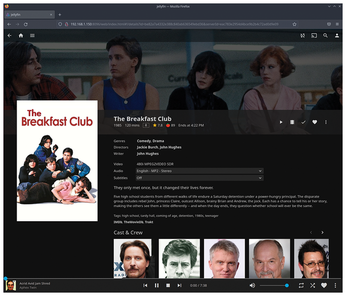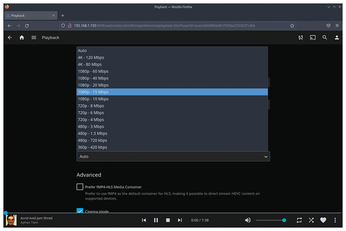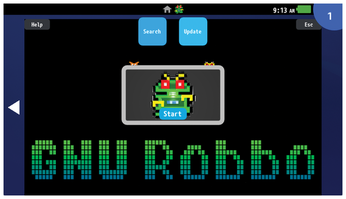Sparkling gems and new releases from the world of Free and Open Source Software
Jellyfin
We appear to be entering something akin to the third age of media streaming, with the first and third ages being focused on self-hosted content, and the second being dominated by streaming giants such as Netflix, Spotify, and Apple. The first age started in the early 2000s when we all started connecting our devices together and building huge collections of digital media from our previously physical containers. This is when protocols like DLNA became popular and when you could buy a set-top box to turn your offline screen into what would now be called a "smart TV." Even the humble PlayStation 2 with its network attachment and a disc called QCast Media Player could stream DivX files from your 2003 Mandrake Linux box. Of course, all of this was swept away by broadband and the arrival of cheap and plentiful subscription services that have dominated for over a decade.
But streaming services are becoming more costly and, more importantly, increasingly fragmented. It's now becoming difficult again to access the media you want in the formats you need. This is where Jellyfin comes in. Jellyfin is an open source equivalent to Plex, where you run your own server and serve your own content. One or more front-end clients can then access the server and stream whatever you want to watch or listen to. There are clients for Android and Apple phones and tablets, and client applications for smart TVs, including an unofficial build for LG's webOS. When all else fails, there's a brilliant web front end running in the server that almost makes any client application redundant. Any one of these will present a beautiful interface that provides quick, responsive access to your content through media, music, and show categories with a list of movie posters, album covers, or box set thumbnails. All of this can be configured along with multiple directories for your various kinds of content, stored locally or remotely.
Installing the server itself is easy with the recommended Docker method, which also has the advantage of keeping your server isolated from the rest of the system. But native installations are just as straightforward. It's particularly well suited to run on a Raspberry Pi which can even be configured to provide hardware transcoding acceleration, as can any generic system or GPU with appropriate drivers. Most of the time, however, real-time transcoding of your media from one format to another is not required. The vast majority of front-ends will be able to play most modern H.264 or H.265 encoded content natively, and we successfully streamed 4K HDR recordings easily from a Raspberry Pi to a smart TV's web browser with very little CPU overhead. This is what differentiates Jellyfin from that first generation of home streaming solutions, because the hardware we now have access to is far more capable, and the experience is mostly seamless. Using Jellyfin is also a great way to aggregate content across a household, especially if you still have a collection of physical media, and it's still often the only way to stream the highest quality content from that media. Even when services support UHD with 4K and HDR content, those streams are themselves often too heavily compressed. Jellyfin lets you stream files natively across your network and beyond, and fits seamlessly with our 21st-century media-consumption habits.
Project Website
 Just like any other streaming service, Jellyfin will automatically populate the poster and thumbnail images, as well as the background information for any content it detects.
Just like any other streaming service, Jellyfin will automatically populate the poster and thumbnail images, as well as the background information for any content it detects.
 If required, Jellyfin can limit the bandwidth it uses, as well as the video and audio capabilities, by transcoding your content in real time.
If required, Jellyfin can limit the bandwidth it uses, as well as the video and audio capabilities, by transcoding your content in real time.
Vita emulator
Vita3K
Valve's Steam Deck is an impressive chunk of portable gaming hardware, but it's only the latest in a long list of previous attempts. Sony's PSP and then Vita were two of the best. They had wonderful ergonomics, and the Vita in particular featured all the controls you could want – dual analog joysticks, shoulder buttons, direction buttons, and a capacitive screen with a touch-sensitive rear. It was moderately successful and featured a library with thousands of games before Sony discontinued the platform and its associated store in 2019. This left a lot of people with large collections of their own games and a diminishing pool of hardware on which to play them. This just happens to be the perfect primordial developer soup for an emulator to appear.
Vita3K is that emulator. It's a project that was started a few years ago, and it's finally becoming capable of running Vita games from start to finish. Its brilliant compatibility database currently lists almost 200 games that will work, with many more working to some extent, and every release adds more. Alongside binaries of the emulator itself, you will need access to the original Vita firmware and the original game files. These can be copied from your original Vita. You will also need to configure and install a few modules for compatibility from the emulator site into the Vita environment, which you can do from the emulator, after which you'll see the emulated Vita launcher with its content manager, settings, and trophy manager. Linux works well with Sony's DualShock controllers, which make the perfect device for use with the emulator as they're closely related to the Vita design. The emulator will show when a device has been connected and recognized. The emulator includes a content manager, settings page, and trophies manager for the trophies you might unlock playing the games. The games themselves are installed from the archived version you take from an original Vita and will load in a separate window. The performance is surprisingly good, and Vita3K is a great way of playing some of the Vita classics that were unique to that system.
Project Website
Buy this article as PDF
(incl. VAT)
Buy Linux Magazine
Subscribe to our Linux Newsletters
Find Linux and Open Source Jobs
Subscribe to our ADMIN Newsletters
Support Our Work
Linux Magazine content is made possible with support from readers like you. Please consider contributing when you’ve found an article to be beneficial.

News
-
Canonical Releases Ubuntu 24.04
After a brief pause because of the XZ vulnerability, Ubuntu 24.04 is now available for install.
-
Linux Servers Targeted by Akira Ransomware
A group of bad actors who have already extorted $42 million have their sights set on the Linux platform.
-
TUXEDO Computers Unveils Linux Laptop Featuring AMD Ryzen CPU
This latest release is the first laptop to include the new CPU from Ryzen and Linux preinstalled.
-
XZ Gets the All-Clear
The back door xz vulnerability has been officially reverted for Fedora 40 and versions 38 and 39 were never affected.
-
Canonical Collaborates with Qualcomm on New Venture
This new joint effort is geared toward bringing Ubuntu and Ubuntu Core to Qualcomm-powered devices.
-
Kodi 21.0 Open-Source Entertainment Hub Released
After a year of development, the award-winning Kodi cross-platform, media center software is now available with many new additions and improvements.
-
Linux Usage Increases in Two Key Areas
If market share is your thing, you'll be happy to know that Linux is on the rise in two areas that, if they keep climbing, could have serious meaning for Linux's future.
-
Vulnerability Discovered in xz Libraries
An urgent alert for Fedora 40 has been posted and users should pay attention.
-
Canonical Bumps LTS Support to 12 years
If you're worried that your Ubuntu LTS release won't be supported long enough to last, Canonical has a surprise for you in the form of 12 years of security coverage.
-
Fedora 40 Beta Released Soon
With the official release of Fedora 40 coming in April, it's almost time to download the beta and see what's new.


